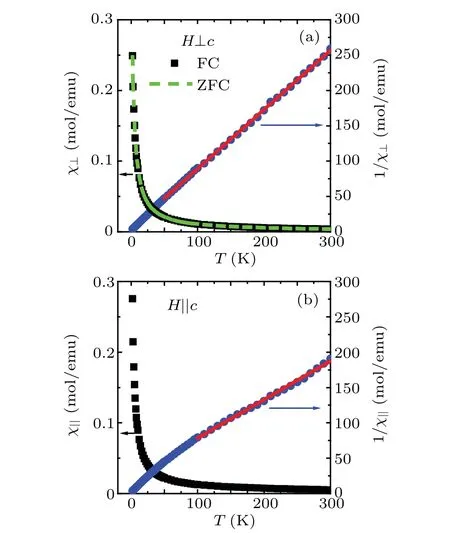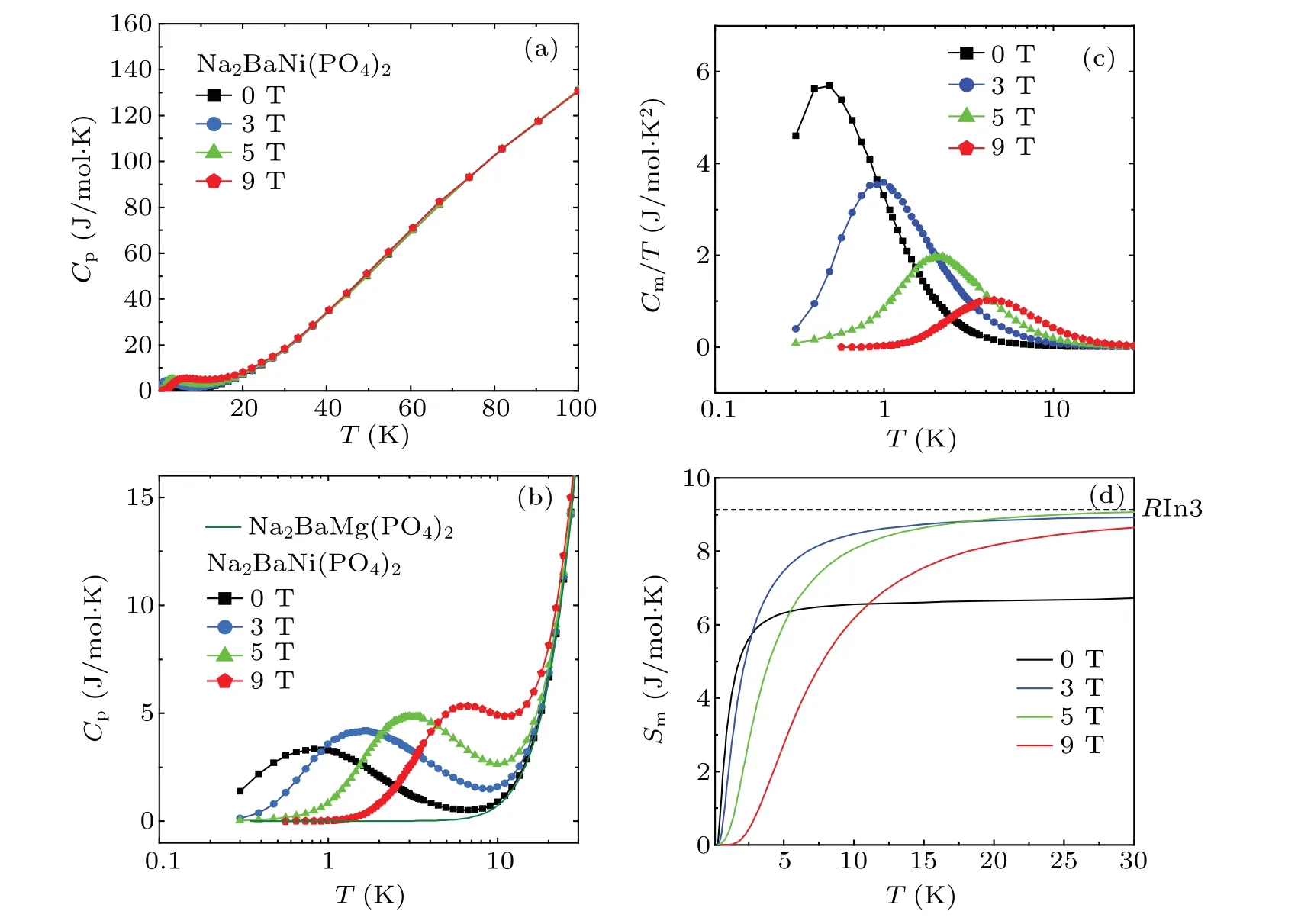Structure and frustrated magnetism of the two-dimensional triangular lattice antiferromagnet Na2BaNi(PO4)2*
Fei Ding(丁飛) Yongxiang Ma(馬雍翔) Xiangnan Gong(公祥南) Die Hu(胡蝶) Jun Zhao(趙俊)Lingli Li(李玲麗) Hui Zheng(鄭慧) Yao Zhang(張耀) Yongjiang Yu(于永江)Lichun Zhang(張立春) Fengzhou Zhao(趙風周) and Bingying Pan(泮丙營)
1School of Physics and Optoelectronic Engineering,Ludong University,Yantai 264025,China
2Analytical and Testing Center,Chongqing University,Chongqing 401331,China
3State Key Laboratory of Surface Physics,Department of Physics,and Advanced Materials Laboratory,Fudan University,Shanghai 200433,China
4School of Chemistry and Materials Science,Ludong University,Yantai 264025,China
Keywords: frustrated magnetism,spin liquid,triangle lattice
1. Introduction
The frustrated triangular lattice antiferromagnets (FTLAs) have been widely studied for their relation to quantum spin liquid (QSL) states.[1-4]The well-knownS=1/2 QSL material candidates include the FTLAs like EtMe3Sb[Pd(dmit)2]2,[5,6]κ-(BEDT-TTF)2Cu2(CN)3,[7,8]and YbMgGaO4.[9]Spin liquid states may also be realized onS= 1 FTLAs such as in Ba3NiSb2O9.[10]Furthermore,the competition of magnetic interactions in FTLA leads to complex phenomena like topological transitions,[11]the 1/3-magnetization plateau in Cs2CuBr4,[12,13]and the successive phase transitions in CsNiBr3.[14]However, real FTLA materials often suffer with problems from lattice distortion and interlayer interactions, so structurally perfect FTLAs are still highly desirable.[15]
Recently, there are reports of FTLA materials in which separatedMO6(M= transition metal ions) octahedra form a perfect two-dimensional triangular lattice.[16,17]The octahedra do not share any oxygen atom with each other,making the antiferromagnetic interactions moderate. For example, in the spin liquid candidate Na2BaCo(PO4)2, the triangular lattice is formed by separated CoO6octahedra.[16]Similar layered triangular lattice structures were observed inAAg2M[VO4]2(A=Ba, Sr;M=Co, Ni)[18]and Na2BaMV2O8(M= Ni,Mn,Co),[17]but these compounds are ferromagnets except for Na2BaMnV2O8.[17]The distinct magnetic properties of these triangular lattice magnets largely stem from the subtle octahedron crystal field environment and superexchange coupling pathways. It is of great interest to explore related materials to search for structurally perfect FTLAs.
Here,we report the structure and magnetic properties of a new FTLA material Na2BaNi(PO4)2.The crystal has a layered magnetic structure. The Ni2+ions withS=1 form a perfect triangular lattice within the magnetic layers and shows antiferromagnetic magnetism.Its magnetization is highly anisotropic betweenχ‖andχ⊥, demonstrating strong easy-plane type anisotropy.Although its Weiss constants areθCW=?6.615 K(H ⊥c)and?43.979 K(H ‖c), no magnetic ordering is observed down to 0.3 K.We also find substantial residual magnetic entropy at zero field.These results reveal the highly frustrated magnetism in Na2BaNi(PO4)2.
2. Experiment
2.1. Synthesis
Single crystals of Na2BaNi(PO4)2were synthesized by the flux method. First, 4 mmol BaCO3(99.99%, Adamas),4 mmol NiO (99%, Aldrich), 8 mmol (NH4)2HPO4(99%,Adamas), and 60 mmol NaCl (99.5%, Greagent) flux media were fully mixed. The mixture was loaded into a 10 mL alumina crucible,capped with a lid,and heated up in a box-type furnace. After staying at 950°C for 2 hours,it was cooled to 750°C at a rate of 3°C/h, and then naturally cooled to room temperature. The obtained crystals were washed in water and separated.
2.2. Single crystal x-ray diffraction
Single crystal x-ray diffraction at 293 K was performed by the Agilent SuperNova diffractometer (MoKαradiation,λ=0.71073 ?A).We used the CrysAlisPro program for x-ray data collection, reduction, and absorption corrections. The SHELXL program package was employed to solve the crystal structure via the direct method.[19,20]
2.3. Magnetic susceptibility and heat capacity measurement
The direct-current(DC)magnetic susceptibility measurements were conducted by a MPMS SQUID magnetometer(Quantum Design) with field applied perpendicular or parallel to thecaxis. The heat capacity was measured by a physical property measurement system(PPMS,Quantum Design)with a dilution refrigerator insert in magnetic fields up to 9 T.
3. Results and discussion
The synthesized hexagonal plate-like single crystals of Na2BaNi(PO4)2are shown in Fig. 1(a). Single crystal structure determination and refinement indicate that the compound crystalizes in a trigonal structure with the space groupP-3. The lattice constants area=b= 5.2790(3) ?A andc=6.9596(4) ?A.Detailed crystal refinement data and atomic coordinates are listed in Tables 1 and 2. It should be noted that our single crystal diffraction did not show detectable site mixing as appeared in some low-dimensional magnets. Crystallographic data of Na2BaNi(PO4)2has been deposited at the Cambridge Crystallographic Data Center(CCDC 2040965).

Fig. 1. Crystal structure of Na2BaNi(PO4)2. (a) Yellow-colored crystals with hexagonal plate-like shape. (b) Layered structure with twodimensional NiO6 octahedra stacking along the c axis. (c)Triangular magnetic lattice in the ab plane. Right panel: NiO6 octahedron unit with ? =93.1(6)°.

Table 1. Crystal data and structure refinement for Na2BaNi(PO4)2.

Table 2. Atomic coordinates and equivalent isotropic displacement parameters(?A2)for Na2BaNi(PO4)2.
The resulted crystal structure of Na2BaNi(PO4)2is illustrated in Figs. 1(b) and 1(c). Ni2+ions (S= 1) form twodimensional triangular lattice layers well separated by the nonmagnetic (PO4)3?, Ba2+, and Na+ions. The magnetic layers follow a simple A-A-A stacking mode along thecaxis(Fig.1(b)).Each Ni2+ion coordinates with six nearest oxygen atoms to form an octahedron, as shown in the right panel of Fig.1(c). Within the NiO6octahedron,the Ni-O bond lengths are 2.050(17) ?A. The octahedron distortion can be characterized by the bond angle?defined in Fig.1(c)which is 93.1(6)°for Na2BaNi(PO4)2,the extent of distortion is similar to that in Na2BaMV2O8(M=Ni,Mn,Co).[17]There is no shared edge or corner between the NiO6octahedra and the magnetic interactions between the spins in the triangular lattice propagate along the Ni-[PO4]-Ni pathway, which should lead to moderate superexchange as observed in related materials.[16-18]In contrast, the interlayer superexchange is along the Ni-[PO4]-[PO4]-Ni pathway (Fig. 1(b)) which should be much smaller than the intralayer interaction, making the system a two-dimensional magnet.
DC magnetic susceptibility (χ) of the Na2BaNi(PO4)2single crystal was measured from 2 K to 300 K with an external field ofH= 1000 Oe. The field was applied either perpendicular or parallel to thecaxis. As can be seen in Fig.2,χ⊥andχ‖monotonically increase with lowering temperature, without any signature of phase transitions down to 2 K. The field-cooling (black squares) and zero-field-cooling(ZFC)(green dashed line)data overlap with each other in the measured temperature range (Fig. 2(a)), excluding the spin glass state. The Curie-Weiss law 1/χ=(T ?θCW)/Cwas used to fit the data between 50 K and 300 K for 1/χ⊥, as indicated by the red lines in Fig.2(a). 1/χ‖, however, deviates from the Curie-Weiss law below 100 K, so the data between 100 K and 300 K were used for fitting (Fig. 2(b)). The fitting results areθCW,⊥=?6.615 K,C⊥=1.195 emu·K/mol andθCW,‖=?43.979 K,C‖=1.836 emu·K/mol forχ⊥(T)andχ‖(T), respectively. The negative Weiss constants indicate that the dominate exchange in Na2BaNi(PO4)2is antiferromagnetic. This is in sharp contrast with its analogous compound Na2BaNi(VO4)2which is a ferromagnet with a transition temperature at 8.4 K.[17]

Fig. 2. Magnetic susceptibility of Na2BaNi(PO4)2 with field (a) perpendicular and(b)parallel to c. The FC data(black squares)and ZFC data(green dashed line)were measured under H =1000 Oe and in the temperature range from 2 K to 300 K.The red solid lines are the Curie-Weiss law fittings for the 1/χ(T)data(blue dots).
The significant difference betweenθCW,⊥andθCW,‖reveals strong magnetic anisotropy in Na2BaNi(PO4)2which reflects strong anisotropic exchange interactions in its spin Hamiltonian. Similar anisotropic magnetism has been found in related layered magnets like Na2BaMV2O8(M=Ni, Mn,Co),[17]BaCo2(AsO4)2,[21]andα-RuCl3.[22]To further reveal the magnetic anisotropy, we measured magnetization atT=300 K, 100 K, 50 K, and 2 K with field perpendicular or parallel to thecaxis, the results are shown in Fig. 3. In Figs. 3(a)-3(d), bothM‖andM⊥increase linearly from 0 to 7 T withM‖apparently larger thanM⊥. The anisotropy can still be observed at 300 K(Fig.3(a)),indicating the anisotropic excitation gap should be comparable to the thermal energy.

Fig. 3. Magnetization at (a) 300 K, (b) 100 K, (c) 50 K, and (d) 2 K.The dotted line in(d)indicates the saturated magnetization value for a Ni2+ ion when only considering the spin moment.
At 2 K,Mis proportional toHat lower fields and tends to saturate at high fields(Fig.3(d)). The theoretical saturated magnetizationMsisgSμB.Msequals to 2μB/Ni2+if only considering the spin moment, consistent with the observed value. The magnetization curves at all measured temperatures have no anomaly, indicating absence of magnetic transitions or long range orderings. The 1/3 magnetization plateau stemming from quantum spins in a triangular lattice is also absent here,implying that Na2BaNi(PO4)2may be treated as a classic FTLA.
The heat capacity data of Na2BaNi(PO4)2at magnetic fields up to 9 T are presented in Fig. 4. The heat capacity above 30 K is field independent and does not show any anomaly related to phase transitions (Fig. 4(a)). However, the low temperature data exhibit a broad peak that shifts to higher temperatures with stronger fields (Fig. 4(b)).This feature is typical in severalS= 1 QSL candidates such as [NH4]2[C7H14N][V7O6F18][23]and Ba3NiSb2O9.[10]SomeS= 1/2 QSL candidates such as YbMgGaO4and Na2BaNi(PO4)2also exhibit similar broad feature in heat capacity at low temperature.[9,16]

Fig.4. (a)Heat capacity of Na2BaNi(PO4)2 below 100 K.(b)Heat capacity in the temperature range from 0.3 K to 30 K.The magnetic fields are at 0 T,3 T,5 T,and 9 T respectively. The heat capacity of Na2BaMg(PO4)2 (olive solid line)was obtained from Ref.[16]. (c)Temperature dependences of Cm/T at different fields. (d)Integrated magnetic entropy Sm of Na2BaNi(PO4)2. RIn3 is the total magnetic entropy for an S=1 magnet.
Magnetic heat capacityCmis sensitive to the low energy spin excitations. We used the heat capacity of Na2BaMg(PO4)2as the phonon contribution in Na2BaNi(PO4)2since they are isostructural (solid line in Fig. 4(b), the data was obtained from Ref. [16]). The temperature dependences ofCm/Tat different fields are displayed in Fig. 4(c). The magnetic entropySm(T) was subsequently obtained by integratingCm/Tfrom~0.3 K toT(Fig.4(d)).For anS=1 magnet,the total magnetic entropy isRIn3,whereRis the ideal gas constant. As can be seen in Fig. 4(d),Smis nearly saturated by 30 K. The zero field magnetic entropy is only 0.74RIn3 at 30 K,indicating substantial residual magnetic entropy below 0.3 K. The zero point entropy usually comes from strong spin fluctuations in disordered systems which lift the degeneracy of the ground state. By applying a magnetic field, the energy barriers of spin reorientations will be enhanced, makingSmincrease to its conventional valueRIn3, consistent with our experimental observed value at magnetic fields(Fig.4(d)).
It is interesting to compare Na2BaNi(PO4)2with its analog compound Na2BaCo(PO4)2, the Co-based triangular lattice antiferromagnet.[16]Both compounds have theMO6-PO4-PO4-MO6(M= Ni, Co) stacking structure along thecaxis. Their lattice constants only have slight differences. For instance, the closest Ni-Ni distance is 5.279 ?A in Na2BaNi(PO4)2and the closest Co-Co distance is 5.319 ?A in Na2BaCo(PO4)2. The similarities in structure result in moderate antiferromagnetic couplings in both compounds.However,the magnetic anisotropy in Na2BaCo(PO4)2is insignificant withΘCW,⊥=?31.9 K andΘCW,‖=?32.6 K,in sharp contrast with the strong magnetic anisotropy in Na2BaNi(PO4)2.The anisotropy is closely related to the anglular distributions of the outmost 3d electron orbits and largely depends on the 3d electron configurations as well as the octahedra crystal field. Further study by inelastic neutron scattering on Na2BaNi(PO4)2is necessary to determine its detailed exchange couplings and anisotropic spin Hamiltonian.
4. Conclusion
In summary,we have synthesized a new antiferromagnet Na2BaNi(PO4)2. From single crystal x-ray diffraction we find that its crystal structure has a perfect two-dimensional triangular lattice formed by Ni2+ions. The Weiss constants are?6.615 K and?43.979 K for field perpendicular and parallel to thecaxis, respectively. However, magnetic ordering is absent down to 0.3 K and up to 9 T. So we conclude that Na2BaNi(PO4)2is a new FLTA that could be used for study of novel states such as QSL in frustrated magnets.
- Chinese Physics B的其它文章
- Numerical investigation on threading dislocation bending with InAs/GaAs quantum dots*
- Connes distance of 2D harmonic oscillators in quantum phase space*
- Effect of external electric field on the terahertz transmission characteristics of electrolyte solutions*
- Classical-field description of Bose-Einstein condensation of parallel light in a nonlinear optical cavity*
- Dense coding capacity in correlated noisy channels with weak measurement*
- Probability density and oscillating period of magnetopolaron in parabolic quantum dot in the presence of Rashba effect and temperature*

